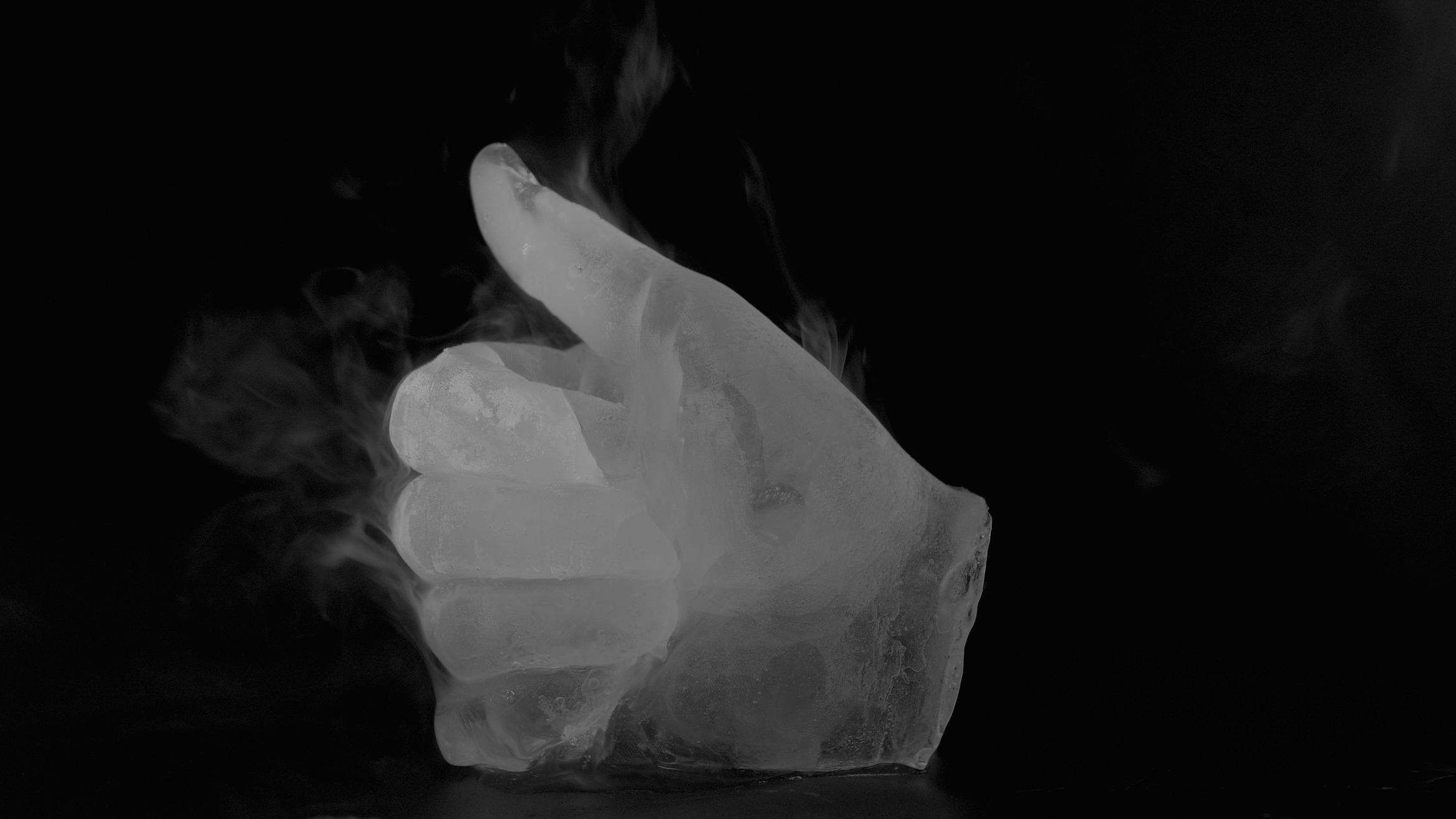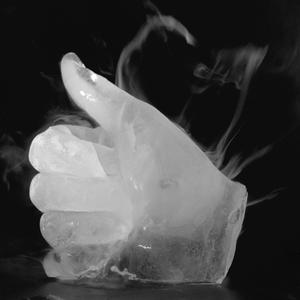James Oram’s By Spectral Hands comprises four distinct works. As you walk through the gallery’s entrance there is a large vitrine work to your left. It has a vivid blue base and encloses a small speaker that is attached to a cable of some kind. On top of the vitrine sits a lonely plastic bottle of water. It looks like a previous visitor may have left it there. The vitrine itself rumbles. The sound lightly displaces the water in the bottle. It is all very subtle and mildly melodic.
According to the wall text, the vitrine encloses a tactile transducer. It changes sound into motion. In this case, it is specifically transforming Edward Bernays’ text Propaganda (1928) into a pervasive force. It is no longer a lingual sign but a field of influence that moves the water within the bottle. It is subliminal. The water container, the bottle, is literally being moved from below. The work is titled Edward’s Noisy Ghost.(1)
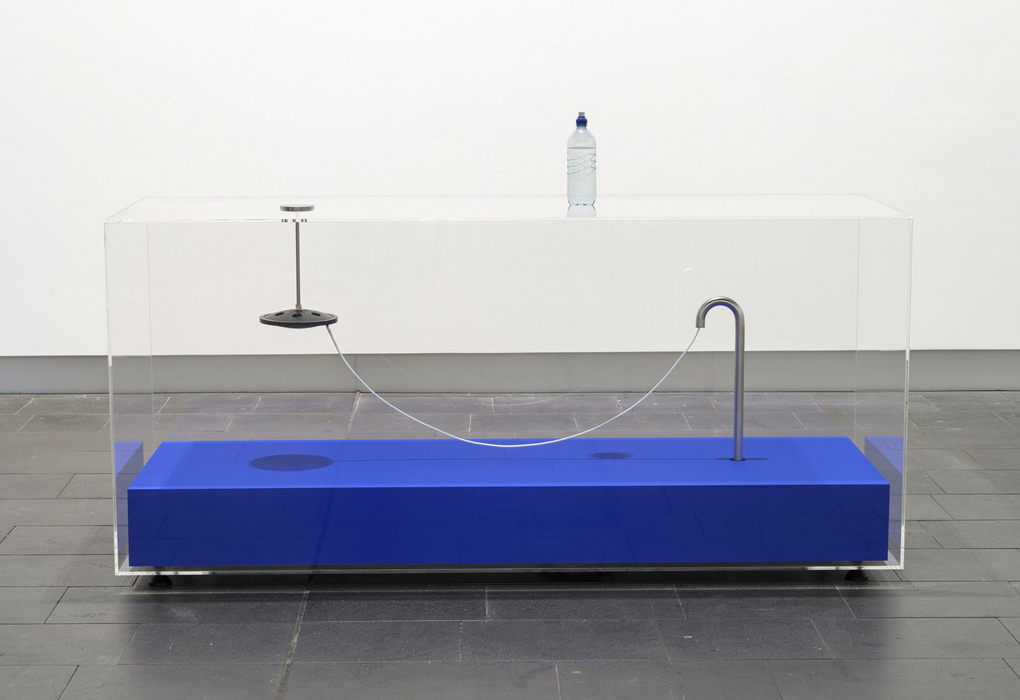
James Oram, By Spectral Hands (2022), Christchurch Art Gallery Te Puna o Waiwhetū (2022). Courtesy of the artist.
The second work you see is a series of cyanotypes; that is, blue toned photographs. They are all variations on hand gestures. Actually, that is not quite accurate. The feeling is that they are clipped details from far larger photos. They are stripped back, apportioned, cropped. They all focus deliberately on the incidental. There are hands in motion, idly swinging behind the back of a body’s gait. Some are thrust forward as if to shake hands. Others point. There is a plethora of gesture, both unintentional and intentional. They are arranged grid like, not helter—skelter. There is an intentional ordering. It is a taxonomy of gesture. They’re printed as cyanotypes. They’re blueprints.
In their formal arrangement they double up with the third work, which by now you’re navigating around. It’s a big brass room divider only its fragile. It’s this large mass but it’s skeletal. You can visibly see the joins that hold it all together. It’s an impasse but it’s also transparent. It’s broken up into grids. Formations that mimic the taxonomy of gesture, only, the room divider is empty. There’s no content. The frame is the content. It’s a format. It doubles down on the taxonomy of gesture.
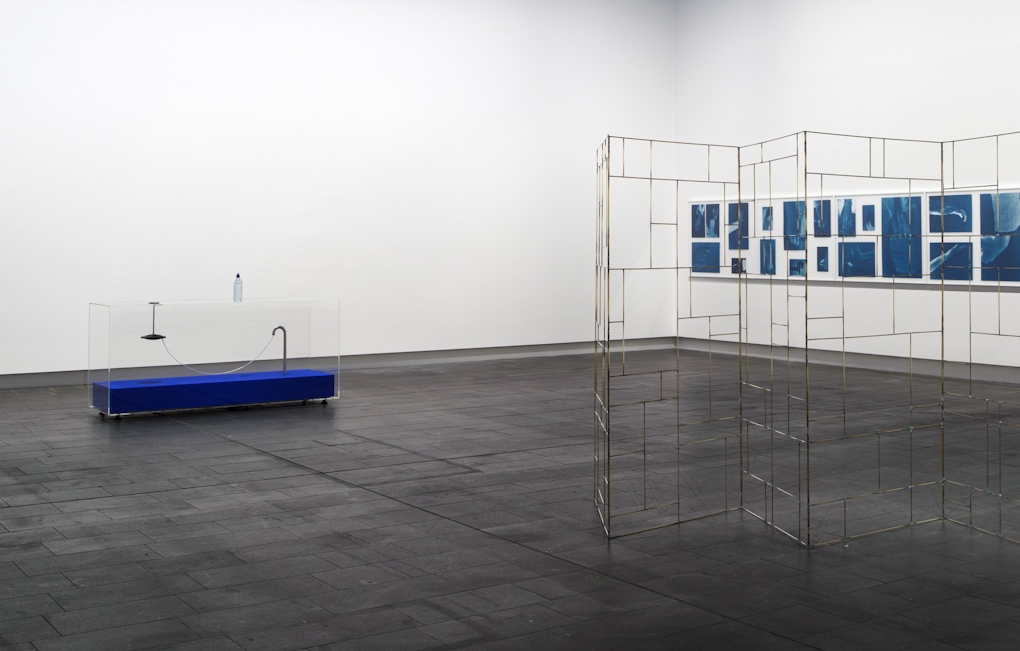
Installation View: James Oram, By Spectral Hands (2022) Christchurch Art Gallery Te Puna o Waiwhetū 2022. Courtesy of the artist.
The fourth work is quite straightforward. It’s a two—screen video, the images placed adjacent to each other. On the left, a thumbs up gesture that has been carved in ice slowly melts. On the right, the same sculpture slowly rematerializes. It is played in reverse. The steam, the condensation gives it away. It’s like watching a boat sink. The base of the hand slowly evaporates, the thumb sinks lower and lower. Like a periscope of a submarine going down. Likewise in its antithesis. The thumb rises, parts the water, crests into visibility. The film plays on loop. It alternates screens. One rising, the other falling. Looping endlessly into meaninglessness. It mimics the actual gesture. The thumbs up. That sign. That social insignia of so many likes.
James Oram, Currency (2022) (excerpt from two—channel video designed for continuous loop)
Four works then. All quite rudimentary to describe. All quite literal. They ply a familiar motif, especially if we believe the wall text, where the show is ostensibly focused on the p.r. hustle of Bernays, who transformed the subconscious principles of Sigmund Freud to streamline the dissemination of the consumer product by normalising desire as the ultimate marketing strategy. For instance, Bernays bombarded the media landscape with the liberating frisson of the cigarette to inculcate their near ubiquity in post war society. The point is that his advertising wasn’t direct, but parallel, subtle, vapourish. Bernays becomes a stock figure in a kind of Adbusters critique of capitalism(2)—or actually semio-capitalism to use Franco Berardi’s term(3)—which focuses on the transformation of a capitalism no longer marshalled by the manipulation and alienation of a worker’s labour from the means of production, but one that operates through signs and desire. It is a capitalism that penetrates into modes of leisure and individuation, sites we’d prefer to keep off limits. All of which is an easy enough target for contemporary art, which deals in signs. But we don’t really need to roll out marketing strategist Kevin Roberts’ Lovemarks(4) as an updating of Bernays’ basic principles to recognise these traits of semio-capitalism right out of the gate. In fact, we could at the very least point to the laconic scepticism of Gen X’s irony to realise that culture has been revolving around this issue for some time now.
It’s useful then to acknowledge that Bernays may be a central figure within the narrative impulse of Oram’s show but I think it’s wrong to extrapolate that critique as the only outcome. In fact, while Oram’s very title “By Spectral Hands” contains overtures to capitalism’s much vaunted invisible hand of the market (that equalising force of self-interest), it also points to the vapourish qualities of this narrative. I propose then that we look past Bernays entirely, to leave him behind as a noisy ghost and to examine instead three under-read reference points within the show that lead to an entirely different outcome. These are:
Yves Klein’s international blue. The immaterial and symbolical use of blue by Oram is quite intentional.(5)
Marianne Wex’s taxonomic record of gendered body posture(6) that overlap with Oram’s interest in hand gestures, particularly his grid formatting.
Giorgio Agamben’s essay, Notes on Gesture which figures gesture as the “proper sphere of that which is human”.(7)
Let’s start with Yves Klein’s blue.
How could the blue base of Oram’s vitrine be anything other than an ode to the immaterial qualities Klein invoked? Or to put it another way; is it ever possible to paint something that blue and not somehow call up the ghost of Yves? Is Oram somehow doubling up this ghosting of advertorial geniuses? Is Klein not an equal to the propagation and marketing of Bernays? Is that not how he is slated; as a rogue salesman whose cynical manipulation of the monochrome belittles art? That’s at least how Guy Debord viewed Klein’s mysticism, claiming Klein freely stole the idea of the monochrome from his film Howls in favour of Sade (1952) only to debase it through commercialism and self-promotion.(8)
And yet for Klein the blue was a mystical proposition. It promised a kind of freedom, an unbridled spirit he inherits from Rosicrucianism. As he stated, “through colour I experience a complete feeling of space, I am truly free”.(9) Colour then, and specifically that colour of blue, was a liberationist strategy for Klein. Blue was not just cleansing but wholly other. It was a zone of immersion, a counterpart to the drudgery of the quotidian. It was aspirational for sure (marketing) but it was also messianic. It was potent. It was a portent. A door opener. It marked not just a threshold but an immaterial access point in which we could go beyond the physical. It was, I suppose, transcendental, and yet it was wholly material. He patented that blue after all. What then is that blue doing at the base of Oram’s vitrine?
There is, then, a clear overlap with the aspirational qualities of Klein’s blue and Oram’s use of it in the base of his vitrine. It becomes a substrate. It is not just a baseline, but a kind of cloud from which the desire manifests. Bernays’ ghost works from within that sphere. That is the true commercialisation of such a messianic structure. To escape the quotidian. We hear all sorts of entreaties today. First it was hair products then a lip gloss, then a gym. It’s the maxim that work on oneself is an elevation of oneself. It’s not evaluative, it’s performative. It’s a logic taken to excess by today’s bitcoin enthusiasts who talk about securing a future, breaking free from the monotony of wage slavery, for conversely, something as equally immaterial. The block-chain becomes another kind immaterial boundary. It beckons freedom but it’s just another trap. It’s as it’s always been. The substrate. To go back to Bernays it’s the subconscious. At the very least it’s aspirational. It’s marketing’s edge. It’s the blue-screen. The space of desire. It’s all equally volatile. As volatile as the water in the water bottle Oram leaves so casually atop his vitrine. That container captures where desire is promulgated from. It’s all an equilibrium. It doesn’t matter what we put in, that zone is always there. In other language it’s called the surplus, the reserve. The water in the container, that’s our bodies on display. The container is rigid. Desire is fluid. Life in this context is immaterial. It’s imaginary.
“Nothing is as imaginary as the material body. Circulating, fluid, borderless, with no certain boundaries or predetermined history, the body has no meaning today other than its intermediations”.(10) Or in Bruno Latour’s terminology, life is irreducible.(11) It can’t be compressed into any one form. That’s not to say that it’s not conditional. Life is always “enframed” to use Cary Wolfe’s term.(12) It is, as Oram’s bottle makes clear, contained. It is precisely this quotidian boundary that we run up against. Life is far from imaginary when we are suffering. And yet, according to the Buddhists, all life is suffering. That is, all life is nothing other than its intermediations, it’s only comprehensible through its articulations and descriptions. How then, do we have such an arbitrary description, a work in a box that sketches the thematic so succinctly and yet no discernible body is there to be described? We have pure schema. Pure thought, pure manipulation. No wonder Bernays triumphs.
Let’s step back a bit.
Marianne Wex’s 1977 taxonomy of bodies in public space was titled “Let’s Take Back Our Space: “Female” and “Male” Body Language as a Result of Patriarchal Structures”.(13) It was composed of photos taken in the street and archetypal images from art history and medical diagrams. Ostensibly the point of the work was to show how gender dictates and shapes the way you inhabit space. So, you get photos of men waiting for the bus. Their legs are splayed, they writhe with a certain frisson. They dally. There’s potential here to say that they entertain what Jane Bennett calls “the infra-body eddies of influx and efflux”.(14) That is, the ebb and flow of a certain barometric reckoning of life, one that’s alert to the ethereal confluence of individual life as one of many. And yet not really. What they are, those indolent men—and it's called to account by Wex’s photographs of women—are indifferent victors. They occupy space carelessly, maliciously. When you see the submissive and minimising tactics Wex highlights in her photographs of women, this barometric reckoning of mens’ posture begins to seem naïve if not, apologetic. And yet maybe we can follow Bennett here:
It is possible today to view Whitman’s(15) [Bennett’s iconographic figure in this narrative of ebb and flow] rhetorical tack as expressive of a naïve optimism or a “disavowal” of race or class, where disavowal names an unacknowledged, selective blindness to social suffering, a self-serving political cowardice, an elision of the hard facts of domination that can only exacerbate the harm. But it is also possible to receive Whitman’s poetics as a political strategy – one aimed at enlivening the will to keep going during dark times and exploring the ways in which indirect responses to social evil can supplement the tactic of head-on opposition. “The indirect is always as great and real as the direct” he says. A more egalitarian, less hateful, more pluralistic, more forward-seeing version of American democracy, for example, will depend not only upon demystification of structures of domination, not only upon militant demands for good government and just laws, but also upon the “radical possession and habit of good heart” upon, that is to say a “sympathetic” cast to the way people perceive and encounter the world. Such a disposition cannot be legislated or produced by demand but requires inducements that are slow, subtle, indirect, persistent and often more poetic than polemical.(16)
Disposition counts. Maybe I could have just said that. Brevity is a gesture after all. Do we know what brevity is. Does it not evince a certain élan, a style. Look over to Oram’s taxonomy of gesture. The signifiers are empty. It’s hard to cache gender. They’re body-less. They’re bodies in motion. There’s a lack of individuation. It belongs to a larger body. They become archetypal. That is they’re blueprints.(17) They’re cyanotypes. And yet they’re all fleeting gestures. They manifest brevity.
According to Agamben, gesture is the bastion of the properly human. He thinks gesture vanishes in semio-capitalism. He calls it the “invisible powers”.(18) He’s thinking of a life conditioned more and more by what Giles Deleuze called the “societies of control”.(19) One led through permissiveness and yet entirely surveilled and scrutinised. It is a life that is monetised as sign, that is easily manipulated through individuation. In fact, in the society of control the more difference proliferates the easier it becomes. No wonder then that Agamben will write, “the more gestures lose their ease under the action of invisible powers, the more life becomes indecipherable”.(20) Gesture in this instance belongs to the domain of the quotidian and yet it is marked as an unmediated rite. It belongs to the immaterial quality of life. Indeed, Agamben suggests that images are the death mask of gesture, they capture the imprint but not the act.(21) Moreover, he suggests images are paralysed by gesture, they provoke us with their stiltedness. He uses the examples of the Mona Lisa (1503-06) and Las Meninas (1656), both inscrutable examples of something elusive. They are images that provoke, they promulgate what Agamben calls “a silent invocation” to “break the spell”, to destroy “the death mask of gesture”.(22)
What is gesture then? Is it the casual indication? The mild flourish? In painting it is often equated with the brush mark. Think of Robert Ryman or the cartoonish flourishes of Roy Lichtenstein’s sculptural brushstrokes. Think of the baroque dandyism of later Frank Stella. How quickly gesture becomes meaningless. All encompassing. Another example of how difference proliferates accommodation. How individuation promotes docility. No! Agamben means something different by gesture. He writes of gesture “evading the orbit of mediality”.(23) It is an act that marks the “being-in-a-medium of human beings”.(24) Gesture then, is sacrosanct. It is liberational like Klein’s blue, but it is also unknown, unconscious, gathered on the whim. To return to Bennett, it is part of one’s disposition. It is incidental and yet entirely convincing. It is part of a becoming that has no secondary perspective. Gesture is the remnant of our lived life. It is unconditional and expressive. It is like the scout at the head of a troop. It is defiantly not the head that destroys the body.
Gesture is then a socio-cultural product, and yet it is only so because it is captured as such.(25) Marianne Wex’s taxonomy makes it transparent how much gesture is conditioned by gender structures that pervade society. Oram takes a different tack here, freeing gesture from the body. It is no longer the gesture of any one particular individual but a range of gestures. It is gesture itself. Freed up like this, gesture allows Oram’s room divider to function as a further taxonomic frame. You look through the frame to realise—like you do when you stand in a Dan Graham sculpture—that you’re the subject under inspection. It’s your navigation of these diagrammatic impositions that count. In Graham it’s often your reflection, or your distortion through the curved glass that produces this awareness. In Oram it’s the slice or cut. Your relation to the taxonomic portioning of the frame that counts. If you’re lucky you’ll encounter another visitor on the other-side and then the whole disposition starts over. It’s like Edward Muybridge’s grid. The body is cut down to mechanical means. Gesture in this instance is capable of being analysed. Or, more to the point, gesture is capable of being apportioned. It is again another instance of individuation, this time at the micro level of gesture.
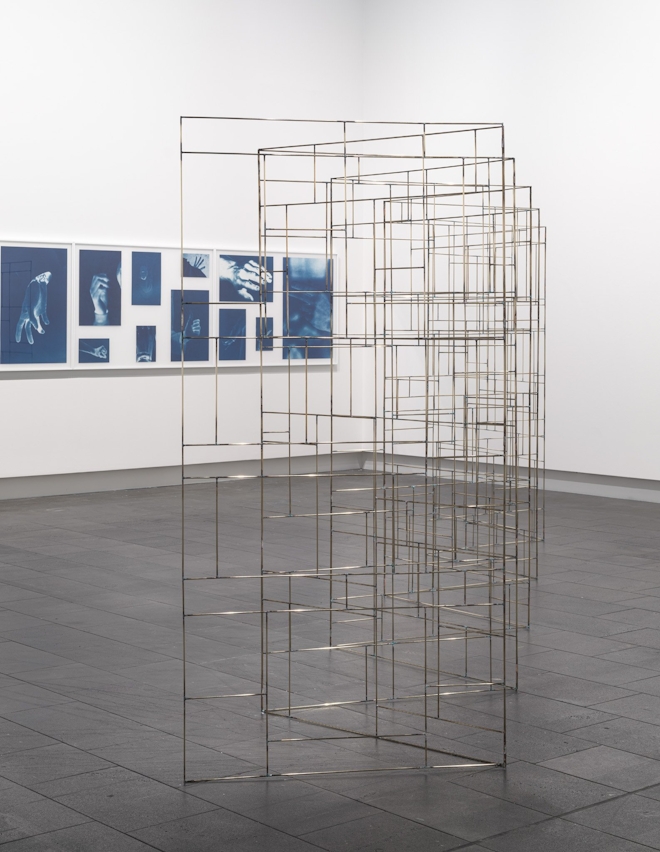
James Oram, By Spectral Hands (2022), Christchurch Art Gallery Te Puna o Waiwhetū (2022). Courtesy of the artist.
Perhaps this makes more sense of Oram’s thumbs up video. Is it not despairingly gothic? The thumb melts, it reappears. It’s gloom laden. It’s Iconoclastic. It détournes the deity. Well, not really, but maybe in an age of social media the thumbs up sign becomes a kind of God? It confers status, it accumulates a kind of aura like so many followers in the church, at the temple. Cornered, conferring, assembling. In Bruno Latour’s terminology so many actors becomes a parliament, a hive of persuasive actors networked together.(26) Such industry now reduced to the docility of so many likes. Individuation is yet again deployed as an isolating strategy. No wonder Berardi takes these maxims of semio-capitalism to their logical outcome in the suicidal ideations of angry young men now swamping society in general:
“It is only in psychopathological terms that the geopolitical dynamic can be deciphered…The Western mind is reacting with a panicked psychosis that could herald a suicidal act. Nothing can interrupt the dynamic of this intersection of paranoid delusions… Many have joined the hordes led by Trump and evangelical preachers. Many took fentanyl and OxyContin until they overdosed. Some grab their father’s gun and go to school to kill half a dozen of their peers. But many others have wondered why they should devote their entire life to poorly paid (or even fairly) paid work when that work makes no sense, depresses you, drains you, and alienates you from others. Why live in conditions of permanent humiliation.”27
Could there be a better icon for such a condition than Oram’s looping video? Endlessly on repeat. The thumb melts, it reappears. Like the token gesture it becomes. Fame is fleeting. It is a house of cards. A materialisation of wish fulfilment. Like the calories of McDonalds, it makes us fat but also induces psychosis. Such is suffering, such is life. Where is Klein’s blue now?
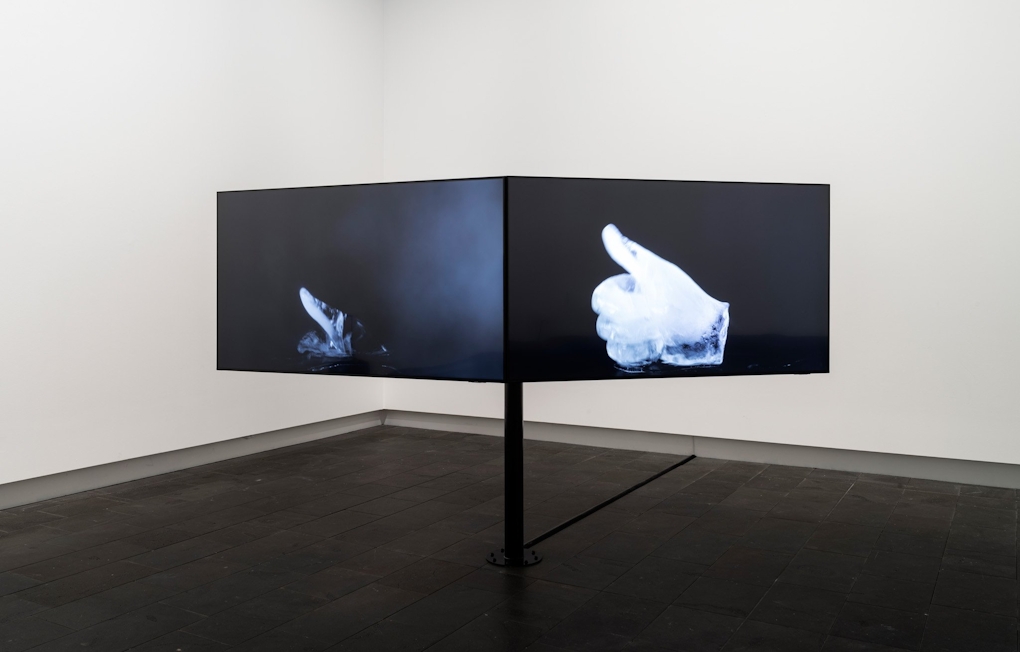
Installation view of Currency (2022) as part of By Spectral Hands, Christchurch Art Gallery Te Puna o Waiwhetū (2022). Courtesy of the artist.
